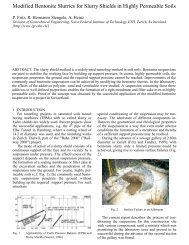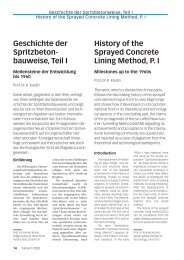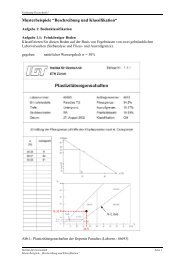Geschichte der Spritzbetonbauweise, Teil IV - ETH - IGT
Geschichte der Spritzbetonbauweise, Teil IV - ETH - IGT
Geschichte der Spritzbetonbauweise, Teil IV - ETH - IGT
Erfolgreiche ePaper selbst erstellen
Machen Sie aus Ihren PDF Publikationen ein blätterbares Flipbook mit unserer einzigartigen Google optimierten e-Paper Software.
nete sich selbst amtlich bis<br />
1994 als „Erfin<strong>der</strong> und Begrün<strong>der</strong><br />
<strong>der</strong> neuen österreichischen<br />
Tunnel- und Tiefbauweise“<br />
(Spang 1996).<br />
Die beiden NÖT-Patente<br />
weisen zwei erstaunliche<br />
Gemeinsamkeiten auf: keines<br />
von ihnen stellt eine eigentliche<br />
Erfindung dar und<br />
beide hörten kurz nach<br />
ihrem Erscheinen auf zu<br />
existieren. Sie unterscheiden<br />
sich vornehmlich in <strong>der</strong> Vorgehensweise<br />
im Profil: Rabcewicz<br />
propagiert den Vollausbruch,<br />
Brunner den <strong>Teil</strong>ausbruch.<br />
Seitdem wird die<br />
NÖT wahlweise einmal nach<br />
Brunner, ein an<strong>der</strong>mal nach<br />
Rabcewicz definiert.<br />
Auch Pacher hat bis 1968<br />
keine Arbeit publiziert, in<br />
<strong>der</strong> die Anwendung von<br />
Spritzbeton und Ankerung<br />
überhaupt jemals Erwähnung<br />
fand. Die von ihm im<br />
Jahre 1964 postulierte muldenförmigeGebirgskennlinie<br />
(Pacher 1964) gewann<br />
aber im Laufe <strong>der</strong> Jahre in<br />
NÖT-Kreisen eine so große<br />
Bedeutung, dass man ihn<br />
seit den 70er-Jahren als einen<br />
<strong>der</strong> Väter <strong>der</strong> NÖT ansah.<br />
So wurde in unzähligen<br />
Veröffentlichungen und<br />
Werbeprospekten über die<br />
angeblich erfolgreiche Anwendung<br />
<strong>der</strong> „Pacherkurve“<br />
zum Zwecke <strong>der</strong> Gebirgsdruck-Optimierungberichtet.<br />
1978 behauptete Müller<br />
(1978) gar: „Das Gesamtkonzept<br />
<strong>der</strong> NÖT fußt auf Pacher’s<br />
Gebirgskennlinie“. Man<br />
kann jedoch leicht zeigen,<br />
dass dieses Konzept das fundamentale<br />
Gesetz <strong>der</strong> Energieerhaltung<br />
in ähnlicher<br />
Weise verletzt wie etwa <strong>der</strong><br />
Gedanke des Perpetuum<br />
mobile. Kürzlich versuchte<br />
Kolymbas (1998) die muldenförmige<br />
Kurve so zu verteidigen:<br />
„Der ansteigende<br />
Ast erscheint als durchaus<br />
sinnvoll, konnte aber bisher<br />
<strong>Geschichte</strong> <strong>der</strong> <strong>Spritzbetonbauweise</strong>, <strong>Teil</strong> <strong>IV</strong><br />
History of the Sprayed Concrete Lining Method, P. <strong>IV</strong><br />
7 NÖT-Patent von Brunner (1955) mit <strong>Teil</strong>ausbruch und Spritzbetonsicherung<br />
ohne Ankerung und Stahlausbau<br />
7 Brunner’s NATM patent (1955), sequential excavation with shotcrete<br />
support without rock bolting and steel sets<br />
we<strong>der</strong> durch Messungen<br />
noch durch numerische Simulation<br />
nachgewiesen werden“.<br />
Mit dieser Aussage<br />
überführt er ungewollt die<br />
Väter <strong>der</strong> NÖT und an<strong>der</strong>e<br />
Protagonisten <strong>der</strong> wissenschaftlichenFalschmünzerei,<br />
berichteten diese doch in<br />
unzähligen Beiträgen von<br />
<strong>der</strong> erfolgreichen Anwendung<br />
<strong>der</strong> Pacherkurve auf<br />
zahlreichen Tunnelbaustellen<br />
(Tauern, Arlberg, Tarbela,<br />
Waldeck etc.). In den Veröffentlichungen<br />
über die NÖT<br />
taucht die Pacherkurve erst<br />
1965 auf (Rabcewicz 1965/1),<br />
convicts the fathers of NATM<br />
and its other protagonists of<br />
scientific fraud, because in<br />
numerous publications they<br />
report on the successful application<br />
of the Pacher curve in<br />
numerous tunnelling projects<br />
(Tauern, Arlberg, Tarbela,<br />
Waldeck, etc.). In the publications<br />
concerning NATM, the<br />
Pacher curve is first mentioned<br />
in 1965 (Rabcewicz<br />
(1965/1) and it was said later<br />
that it embodies the “complete<br />
concept of NATM“.<br />
Müller did not align himself<br />
with the protagonists of NATM<br />
until 14 years after its intro-<br />
duction (Müller and Spaun<br />
1977). His main contribution<br />
was to trivialise the science<br />
and technology of conventional<br />
tunnelling with his 22<br />
oracle-like NATM principles, of<br />
which a number have already<br />
been cited (Müller and Fecker<br />
1978, Austrian National Committee<br />
“Un<strong>der</strong>ground Construction”<br />
of the ITA 1980).The<br />
correct formulations were<br />
borrowed from the common<br />
intellectual property of international<br />
tunnelling, whereas<br />
the others are the typical<br />
products of NATM ideology.<br />
Consi<strong>der</strong> the 6th NATM principle:<br />
“Construct the lining not<br />
too early or too late, and not<br />
too rigidly or too flexibly”. Despite<br />
such woolly thinking,<br />
Müller urgently warns us “the<br />
slightest deviation from the<br />
principles may be detrimental<br />
to the safety of the workmen”<br />
(Müller 1979). As to the key argument,<br />
it is repeated again<br />
and again “with NATM, the<br />
ground supports itself”, or the<br />
requirement to make the<br />
“supports bond with the<br />
ground“ (9th NATM principle)<br />
we refer to Simms (1844). A<br />
critical analysis of the other<br />
principles of the complete<br />
NATM “edifice of thoughts”<br />
has been published elsewhere<br />
(Kovári 1994, 1995).<br />
In summing up, it can be<br />
asserted that the NATM protagonists<br />
firstly misappropriate<br />
the common intellectual<br />
property of the international<br />
tunnelling community, secondly<br />
that scientific knowledge<br />
is mixed up with pseudoscientific<br />
postulates, and<br />
thirdly that this mix is aggressively<br />
marketed. The confusion<br />
thus created among professional<br />
engineers is accepted<br />
without consi<strong>der</strong>ing the<br />
unfavourable consequences<br />
this could have on the<br />
education of the new generation<br />
of tunnelling engineers.<br />
Tunnel 5/2002 19






